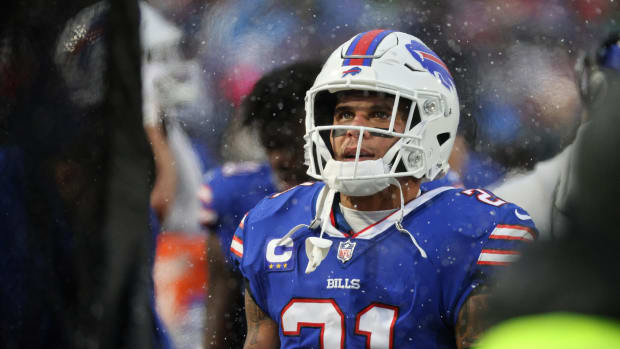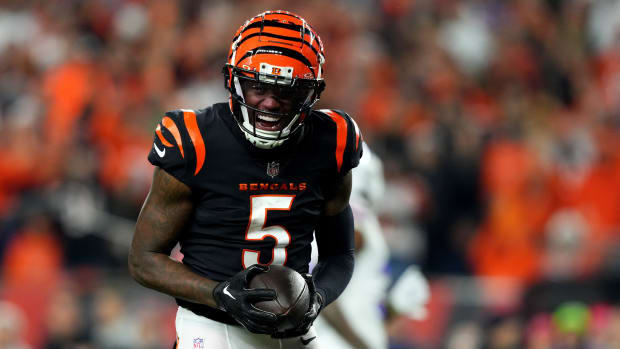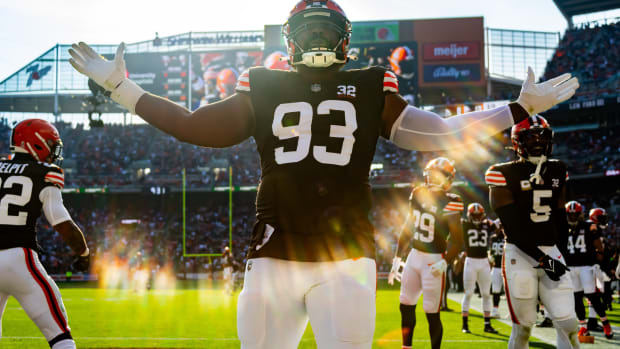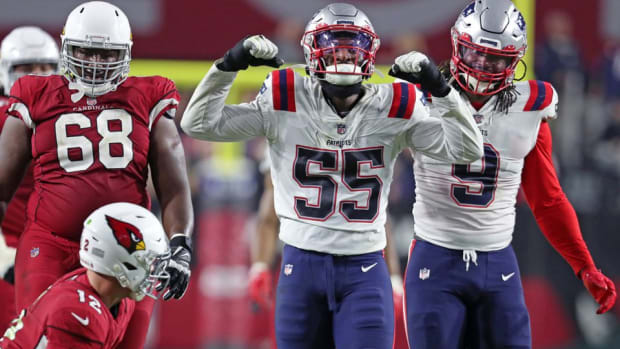The Trouble with NFL Offensive Linemen: Bad Starts and Worse Finishes
The Giants and Seahawks both have Super Bowl-winning quarterbacks, excellent defenses and playmakers on offense. And both have high expectations for this season. But neither team could figure out a way to muster a touchdown on Sunday.
Even though it’s just Week 1, it seems fair to ask: Can you really be a contender without a good offensive line?
The epidemic of poor offensive line play is something we are hearing more and more about across the NFL. Some blame the practice rules imposed by the 2011 CBA, which limit both offseason practice time and the number of padded practices in which linemen can get in full-contact reps. Others point to the rise of spread offenses in college, where linemen often aren’t asked to finish blocks or even put their hand in the dirt in a three-point stance.
“That’s a question for the offseason,” Giants coach Ben McAdoo said on Monday, less than 24 hours after his team’s 19-3 season-opening loss to the Cowboys. “We need to find a way to win a ballgame this week and find a way to get better up front in a hurry.”
The Morning Huddle: Why Were NFL Quarterbacks So Bad in Week 1?
He’s right—but the key question, now that the season is underway, is how much better can the Giants’ and the Seahawks’ offensive lines really get? The Giants opted to go with the same starting five as last season, despite the unit’s struggles in 2016. They had been banking on left tackle Ereck Flowers, their first-round pick in 2015, taking a big step forward in Year 3. The Seahawks, meanwhile, put stock in another year of experience for their young draft picks, and they signed free agent Luke Joeckel, the former No. 2 overall pick, after the Jaguars let him walk.
The early returns were not pretty. You may have seen that disheartening freeze frame from the Seahawks’ 17-9 loss to the Packers circulating on social media: Russell Wilson on a third-and-10, a good 15 yards behind the line of scrimmage, trying to run away from three Packers defenders. The only thing left to do for the four offensive linemen who got beat was to chase the players chasing their quarterback. Wilson got rid of the ball, completing a throw to tight end Jimmy Graham, for a loss of one yard.
It wasn’t even the worst play of the night—that would be the third-down strip sack of Wilson in the third quarter, on which the game turned for the Packers. Defensive tackle Mike Daniels, who had beaten right guard Mark Glowinski for a sack of Wilson just two plays earlier, this time beat the left guard, Joeckel, with a similar inside move and knocked the ball loose. The Packers recovered on Seattle’s 6-yard line and scored a touchdown on the next snap.
The Giants’ woes up front weren’t quite as dramatic—McAdoo praised Eli Manning for keeping two hands on the ball and not fumbling, which gives you an idea of how often he was in a pressure situation—but they are no less concerning. The Cowboys don’t have a particularly talented front, but Demarcus Lawrence and Charles Tapper looked like Von Miller or Khalil Mack against right guard John Jerry and right tackle Bobby Hart (Hart was hampered by an ankle injury). In particular, the Giants struggled with third-down stunts, a rather routine tactic used by defenses on passing downs. “We had some technical breakdowns,” McAdoo said.
In fairness, both the Giants and the Seahawks lost on the road to defending division champions. The Packers have a talented front seven, and Cowboys defensive coordinator Rod Marinelli has had a track record of getting a performance out of his unit that is greater than the sum of its parts. Also, most coaches will tell you that the defense is always ahead of the offense early in the season, and that the last piece of an offense to come together is usually its pass protection, because of the required unison between several players.
Three & Out: Takeaways from the Denver Broncos’ Win over the Los Angeles Chargers
But, for two teams that have the potential to be contenders (and for several others who do not) the play of the offensive line on opening weekend was a glaring weakness. The unit has been a sore point for the Seahawks since the spring of 2015, when, after making their second trip to the Super Bowl in two seasons, they traded All-Pro center Max Unger and a first-round pick to the Saints in exchange for tight end Jimmy Graham. The Giants’ two Super Bowl titles in the past decade featured strong line play on both sides of the ball, but as the stalwarts on those teams slowly faded to retirement, the Giants have struggled to replenish the same quality of play on the offensive line.
The two theories mentioned above—the new practice rules and the rise of collegiate spread offenses—have no doubt played a role in some of the ugly NFL line play. It takes more time for players to adjust from college to pro-style offenses, and they have less practice time to do so. And that’s magnified by the fact that the NFL becomes more and more of a passing league each year. Geoff Schwartz, a seventh-round draft pick out of Oregon in 2008, played eight seasons in the NFL (including two with the Giants) and recalls needing a few months as a rookie to master his three-point stance, and then having to re-work it in the offseason with the help of veteran teammate Jordan Gross. But he was on the practice squad his first season, so he had time to adjust.
“In college, there is so much misdirection, and the tempo is so fast at times, you don’t even have to really block anybody because the defense is so tired,” Schwartz said. “What we’ve really lost in college is the idea of finishing. In the NFL, you have to finish to be an elite offensive lineman. In college, your goal is to get back to the line of scrimmage and snap the ball again. The mentality of not finishing in college hurts you when you get to the NFL.”
Nick Hardwick, who played 11 seasons as the Chargers’ center before retiring in 2014, suggests another theory for the decline in play. “I’ve talked to some nose tackles and defensive tackles around the league who say the craftiness from offensive linemen is dissipating,” he said. “Guys understand the basics of the game—hat placement, eye placement, footwork, hands—but they don’t understand the nuances that take their game to the next level. The subtleties of having a personal game plan for how to set up your opponent, so you are not countering his moves, he’s countering yours.”
How the Dolphins, Buccaneers and Jaguars Are Dealing with the Aftereffects of Irma
What about the teams that have had success up front? The Cowboys and the Titans, for example, have invested high draft picks in players with experience playing in pro-style offenses at the college level. The Raiders, on the other hand, spent a lot of money in free agency over the last few years to build a line that is among the best in the league. These teams have not only invested the resources, but so far they seem to have used them wisely. In the 2016 draft, for example, the Titans traded up to pick tackle Jack Conklin from Michigan State at No. 8 overall. Last season, he was named first team All-Pro. A year earlier, the Giants stayed put at No. 10 to draft Flowers, who has immense physical talent but had some technique issues coming out of Miami that he’s yet to overcome.
That’s not to say Flowers, and some of the other young players on the Seattle and New York lines, won’t take steps forward this season. Take the case of Eric Fisher, the No. 1 overall pick in 2013, who struggled early on and was even demoted from his left tackle job as recently as two years ago. He bounced back and has developed into a solid left tackle who earned a four-year contract extension last summer. The Chiefs offensive line has emerged as one of the better units in the league and was key to the team’s upset win over the Patriots last Thursday.
McAdoo said they’d consider lineup changes, or tweaks to the scheme to give the offense a better chance up front. Of course, players who have been there before say there’s only so much you can do at this point in the season. If there’s just one weak spot on the line, coaches can scheme to send extra help his direction with running backs or tight ends chipping, and by having the QB get rid of the ball quickly. But both the Giants and Seahawks have shown flaws at multiple positions up front.
“At some point, they are going to run into a unit on the other side of the ball that is going to be able to pierce that front and make it an absolute nightmare for either Russell Wilson or Eli Manning,” Hardwick said. “By having a poor offensive line, you cap off the potential of your team.”
That’s the big question both teams are facing this season. With the season already underway, can they raise the level of play on their offensive line or make enough adjustments in order to make a deep playoff run? Or, will their performance up front yet again hold them back this season? It’s an important question, and one that’s becoming even more important in today’s NFL.
Question? Comment? Story idea? Let us know at talkback@themmqb.com




































